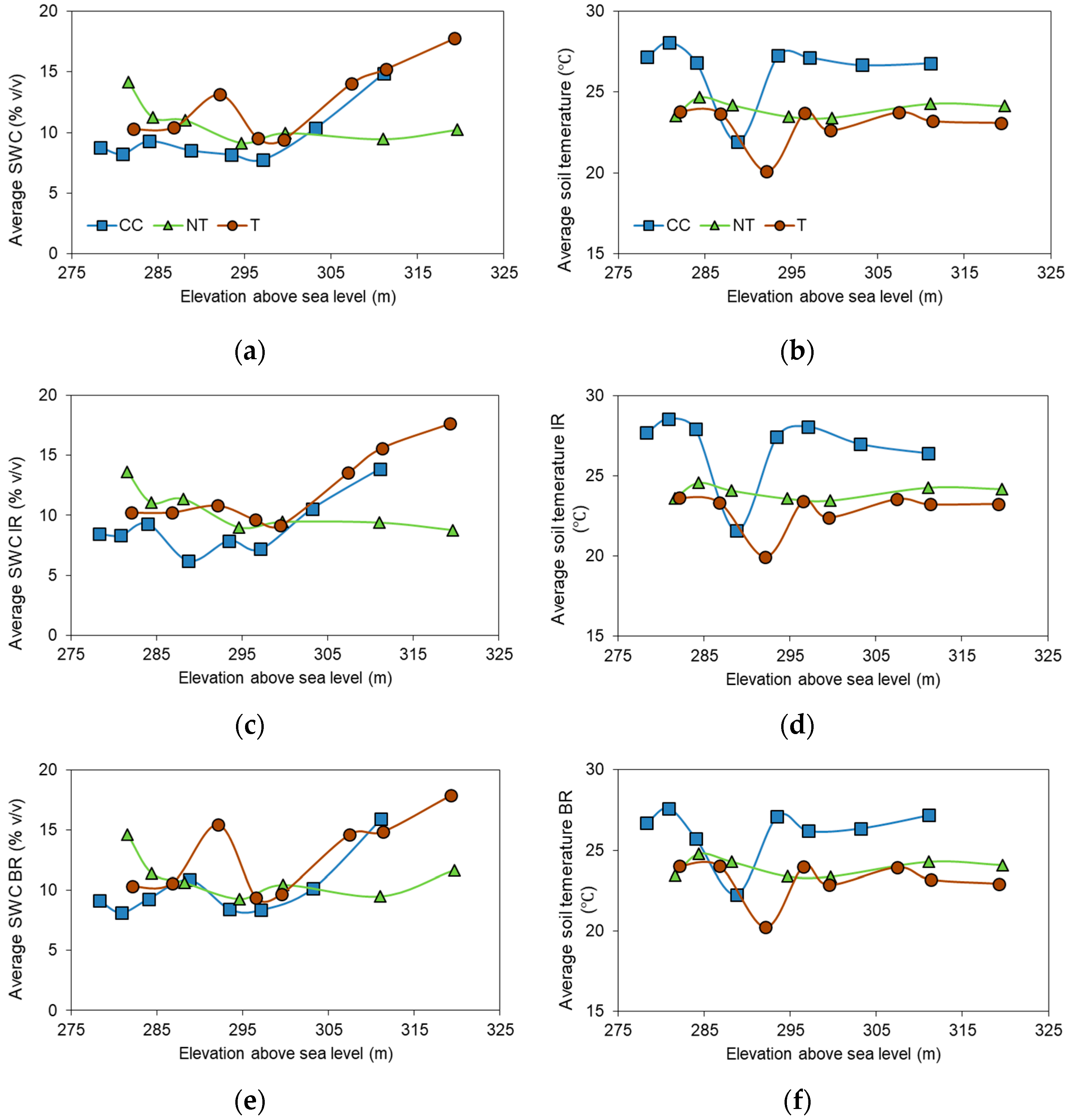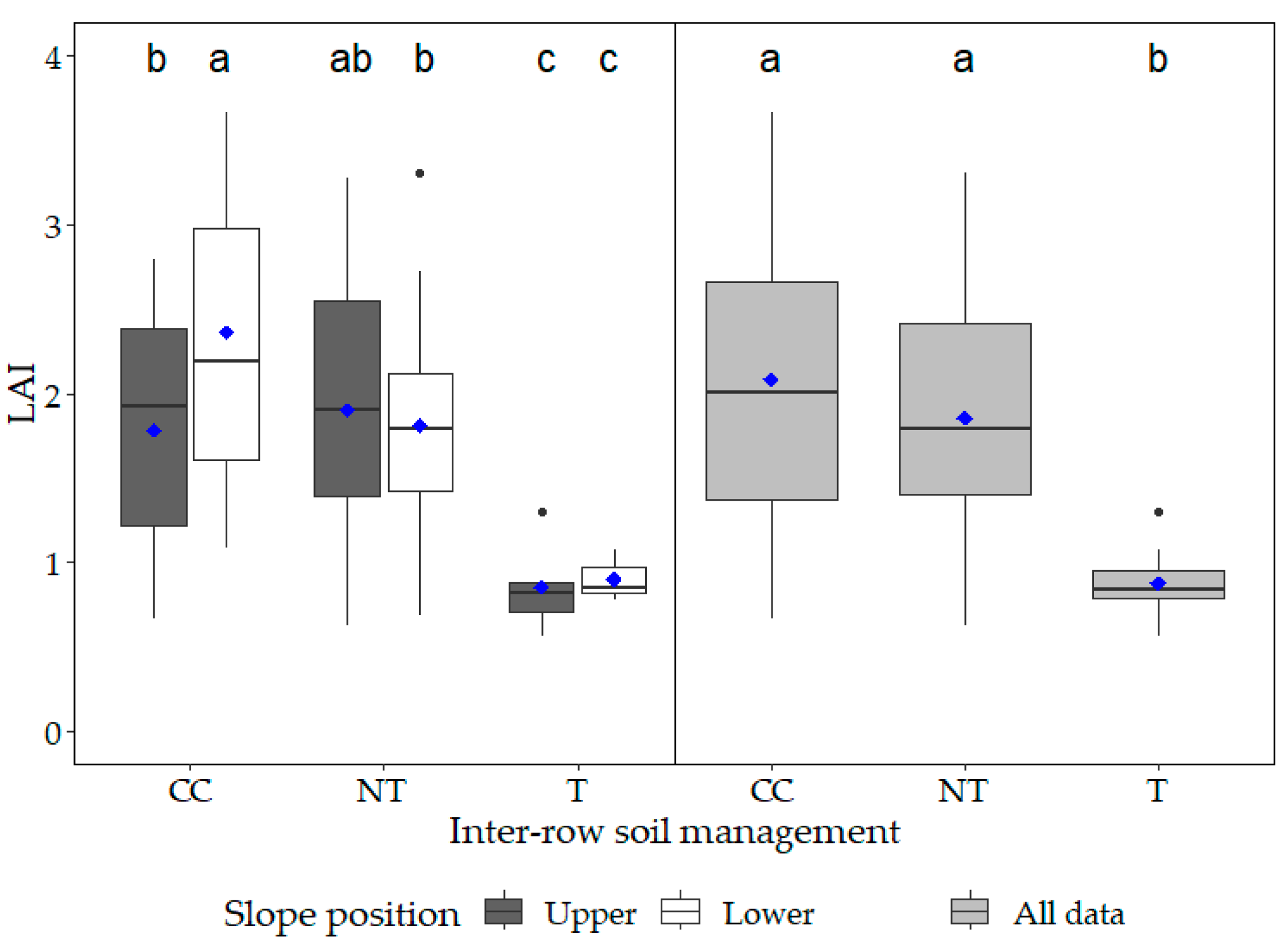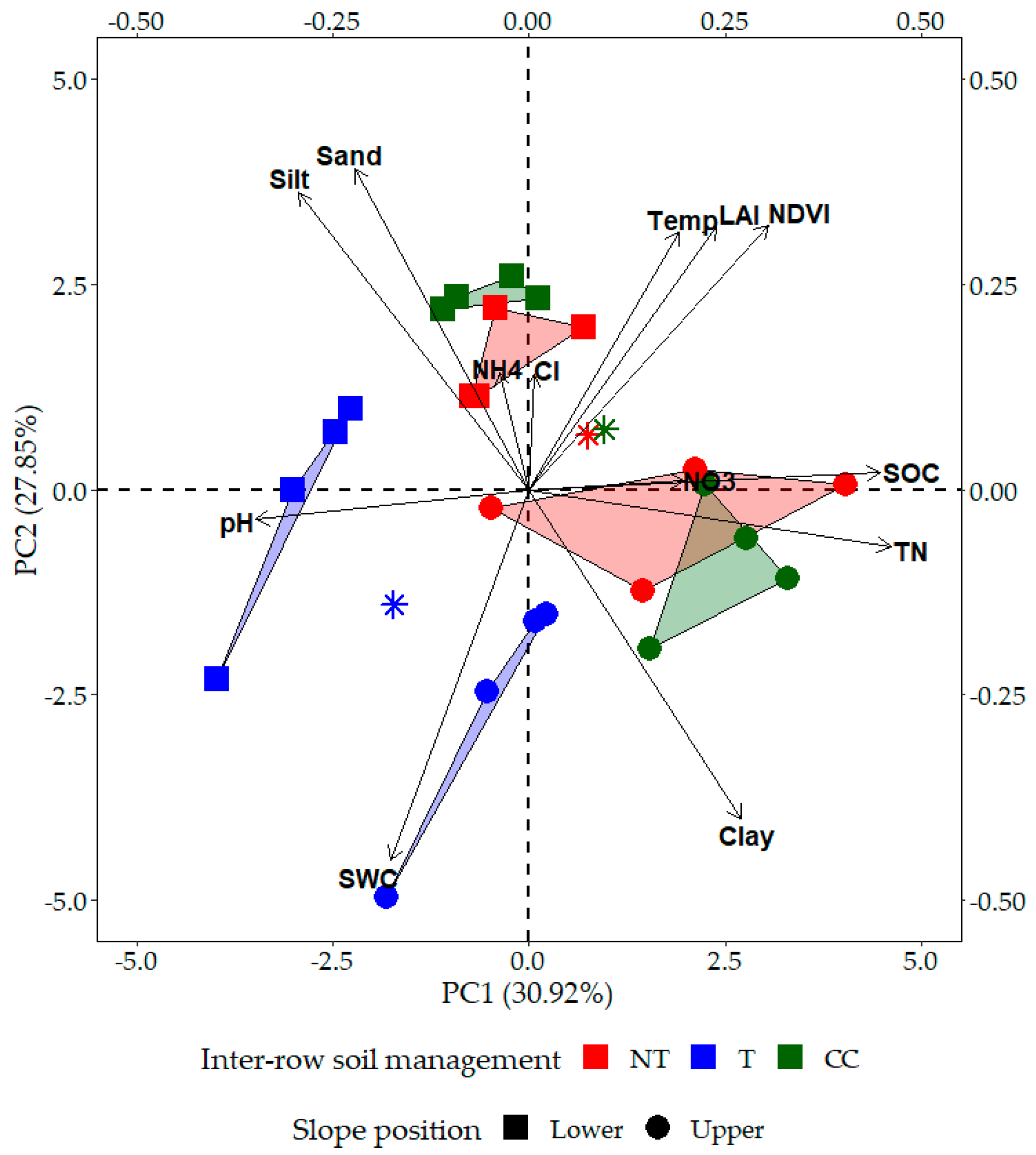Plant Growth and Soil Water Content Changes under Different Inter-Row Soil Management Methods in a Sloping Vineyard
Abstract
:1. Introduction
2. Materials and Methods
2.1. Site Description
2.2. Soil Sampling and Analyses
2.3. Soil Water Content and Temperature
2.4. Plant Measurements
2.5. Statistical Analysis
3. Results
3.1. Comparison of Soil Physical and Chemical Properties between Treatments and Slope Positions
3.2. Soil Water Content and Temperature Changes during Plant Growth
3.3. Inter-Row Management Effects on Vegetation Indices
3.4. Relationships between Soil and Plant Properties
4. Discussion
5. Conclusions
Author Contributions
Funding
Data Availability Statement
Acknowledgments
Conflicts of Interest
References
- IPCC. Mitigation of Climate Change. Contribution of Working Group III to the Fifth Assessment Report of the Intergovernmental Panel on Climate Change; University Press: Cambridge, UK, 2014. [Google Scholar]
- Horel, Á.; Zsigmond, T.; Molnár, S.; Zagyva, I.; Bakacsi, Z. Long-term soil water content dynamics under different land uses in a small agricultural catchment. J. Hydrol. Hydromech. 2022, 70, 284–294. [Google Scholar] [CrossRef]
- Czigány, S.; Sarkadi, N.; Lóczy, D.; Cséplő, A.; Balogh, R.; Fábián, S.Á.; Ciglič, R.; Ferk, M.; Pirisi, G.; Imre, M. Impact of Agricultural Land Use Types on Soil Moisture Retention of Loamy Soils. Sustainability 2023, 15, 4925. [Google Scholar] [CrossRef]
- Tromp-van Meerveld, H.; McDonnell, J.J. On the interrelations between topography, soil depth, soil moisture, transpiration rates and species distribution at the hillslope scale. Adv. Water Resour. 2006, 29, 293–310. [Google Scholar] [CrossRef]
- Langston, A.L.; Tucker, G.E.; Anderson, R.S.; Anderson, S.P. Evidence for climatic and hillslope-aspect controls on vadose zone hydrology and implications for saprolite weathering. Earth Surf. Process. Landf. 2015, 40, 1254–1269. [Google Scholar] [CrossRef]
- Seneviratne, S.I.; Corti, T.; Davin, E.L.; Hirschi, M.; Jaeger, E.B.; Lehner, I.; Orlowsky, B.; Teuling, A.J. Investigating soil moisture–climate interactions in a changing climate: A review. Earth-Sci. Rev. 2010, 99, 125–161. [Google Scholar] [CrossRef]
- Srivastava, A.; Yetemen, O.; Kumari, N.; Saco, P. Aspect-controlled spatial and temporal soil moisture patterns across three different latitudes. In Proceedings of the 23rd International Congress on Modeling and Simulation (MODSIM2019), Canberra, Australia, 1–6 December 2019; pp. 1–6. [Google Scholar]
- Hillel, D. Fundamentals of Soil Physics; Academic Press: Cambridge, MA, USA, 2013. [Google Scholar]
- Munawar, A.; Blevins, R.; Frye, W.; Saul, M. Tillage and cover crop management for soil water conservation. Agron. J. 1990, 82, 773–777. [Google Scholar] [CrossRef]
- Mukherjee, S.; Mishra, A.; Trenberth, K.E. Climate change and drought: A perspective on drought indices. Curr. Clim. Chang. Rep. 2018, 4, 145–163. [Google Scholar] [CrossRef]
- Kis, A.; Pongrácz, R.; Bartholy, J.; Gocic, M.; Milanovic, M. Multi-scenario and multi-model ensemble of regional climate change projections for the plain areas of the Pannonian Basin. Időjárás/Q. J. Hung. Meteorol. Serv. 2020, 124, 157–190. [Google Scholar] [CrossRef]
- Zhao, L.; Hou, R.; Wu, F.; Keesstra, S. Effect of soil surface roughness on infiltration water, ponding and runoff on tilled soils under rainfall simulation experiments. Soil Tillage Res. 2018, 179, 47–53. [Google Scholar] [CrossRef]
- Novara, A.; Gristina, L.; Saladino, S.S.; Santoro, A.; Cerdà, A. Soil erosion assessment on tillage and alternative soil managements in a Sicilian vineyard. Soil Tillage Res. 2011, 117, 140–147. [Google Scholar] [CrossRef] [Green Version]
- Novara, A.; Cerda, A.; Barone, E.; Gristina, L. Cover crop management and water conservation in vineyard and olive orchards. Soil Tillage Res. 2021, 208, 104896. [Google Scholar] [CrossRef]
- Capello, G.; Biddoccu, M.; Ferraris, S.; Cavallo, E. Effects of tractor passes on hydrological and soil erosion processes in tilled and grassed vineyards. Water 2019, 11, 2118. [Google Scholar] [CrossRef] [Green Version]
- Ferrero, A.; Usowicz, B.; Lipiec, J. Effects of tractor traffic on spatial variability of soil strength and water content in grass covered and cultivated sloping vineyard. Soil Tillage Res. 2005, 84, 127–138. [Google Scholar] [CrossRef]
- Jakab, G.; Szabó, J.; Szalai, Z.; Mészáros, E.; Madarász, B.; Centeri, C.; Szabó, B.; Németh, T.; Sipos, P. Changes in organic carbon concentration and organic matter compound of erosion-delivered soil aggregates. Environ. Earth Sci. 2016, 75, 144. [Google Scholar] [CrossRef] [Green Version]
- Szalai, Z.; Szabó, J.; Kovács, J.; Mészáros, E.; Albert, G.; Centeri, C.; Szabó, B.; Madarász, B.; Zacháry, D.; Jakab, G. Redistribution of soil organic carbon triggered by erosion at field scale under subhumid climate, Hungary. Pedosphere 2016, 26, 652–665. [Google Scholar] [CrossRef] [Green Version]
- Slattery, M.C.; Burt, T.P. Particle size characteristics of suspended sediment in hillslope runoff and stream flow. Earth Surf. Process. Landf. 1997, 22, 705–719. [Google Scholar] [CrossRef]
- Mesoro, B.G.; Sebok, A.; Waltner, I. A field-level study of soil penetration resistance, moisture content and infiltration. In Proceedings of the 3rd International Conference On Water Sciences, Szarvas, Hungary, 22–24 March 2022; pp. 24–29. [Google Scholar]
- Hall, A.; Lamb, D.W.; Holzapfel, B.; Louis, J. Optical remote sensing applications in viticulture—A review. Aust. J. Grape Wine Res. 2002, 8, 36–47. [Google Scholar] [CrossRef]
- Gutiérrez-Gamboa, G.; Zheng, W.; Martínez de Toda, F. Strategies in vineyard establishment to face global warming in viticulture: A mini review. J. Sci. Food Agric. 2021, 101, 1261–1269. [Google Scholar] [CrossRef]
- Glenn, E.P.; Huete, A.R.; Nagler, P.L.; Nelson, S.G. Relationship between remotely-sensed vegetation indices, canopy attributes and plant physiological processes: What vegetation indices can and cannot tell us about the landscape. Sensors 2008, 8, 2136–2160. [Google Scholar] [CrossRef] [Green Version]
- Gamon, J.A.; Field, C.B.; Goulden, M.L.; Griffin, K.L.; Hartley, A.E.; Joel, G.; Penuelas, J.; Valentini, R. Relationships between NDVI, canopy structure, and photosynthesis in three Californian vegetation types. Ecol. Appl. 1995, 5, 28–41. [Google Scholar] [CrossRef] [Green Version]
- Padilla, F.M.; Gallardo, M.; Peña-Fleitas, M.T.; De Souza, R.; Thompson, R.B. Proximal optical sensors for nitrogen management of vegetable crops: A review. Sensors 2018, 18, 2083. [Google Scholar] [CrossRef] [PubMed] [Green Version]
- Zsigmond, T.; Braun, P.; Mészáros, J.; Waltner, I.; Horel, Á. Investigating plant response to soil characteristics and slope positions in a small catchment. Land 2022, 11, 774. [Google Scholar] [CrossRef]
- Wang, J.; Rich, P.M.; Price, K.P.; Kettle, W.D. Relations between NDVI, grassland production, and crop yield in the Central Great Plains. Geocarto Int. 2005, 20, 5–11. [Google Scholar] [CrossRef]
- Liu, Y.; Liu, S.; Sun, Y.; Li, M.; An, Y.; Shi, F. Spatial differentiation of the NPP and NDVI and its influencing factors vary with grassland type on the Qinghai-Tibet Plateau. Environ. Monit. Assess. 2021, 193, 48. [Google Scholar] [CrossRef]
- Huemmrich, K.F.; Goward, S.N. Vegetation canopy PAR absorptance and NDVI: An assessment for ten tree species with the SAIL model. Remote Sens. Environ. 1997, 61, 254–269. [Google Scholar] [CrossRef]
- Wang, Q.; Adiku, S.; Tenhunen, J.; Granier, A. On the relationship of NDVI with leaf area index in a deciduous forest site. Remote Sens. Environ. 2005, 94, 244–255. [Google Scholar] [CrossRef]
- Johnson, L.F. Temporal stability of an NDVI-LAI relationship in a Napa Valley vineyard. Aust. J. Grape Wine Res. 2003, 9, 96–101. [Google Scholar] [CrossRef]
- Santin-Janin, H.; Garel, M.; Chapuis, J.-L.; Pontier, D. Assessing the performance of NDVI as a proxy for plant biomass using non-linear models: A case study on the Kerguelen archipelago. Polar Biol. 2009, 32, 861–871. [Google Scholar] [CrossRef]
- Stamatiadis, S.; Taskos, D.; Tsadila, E.; Christofides, C.; Tsadilas, C.; Schepers, J.S. Comparison of passive and active canopy sensors for the estimation of vine biomass production. Precis. Agric. 2010, 11, 306–315. [Google Scholar] [CrossRef] [Green Version]
- Er-Raki, S.; Rodriguez, J.C.; Garatuza-Payan, J.; Watts, C.J.; Chehbouni, A. Determination of crop evapotranspiration of table grapes in a semi-arid region of Northwest Mexico using multi-spectral vegetation index. Agric. Water Manag. 2013, 122, 12–19. [Google Scholar] [CrossRef]
- Lu, S.; Xuan, J.; Zhang, T.; Bai, X.; Tian, F.; Ortega-Farias, S. Effect of the shadow pixels on evapotranspiration inversion of vineyard: A high-resolution UAV-based and ground-based remote sensing measurements. Remote Sens. 2022, 14, 2259. [Google Scholar] [CrossRef]
- Dövényi, Z. Magyarország Kistájainak Katasztere; MTA Földrajztudományi Kutatóintézet: Budapest, Hungary, 2010; p. 876. (In Hungarian) [Google Scholar]
- IUSS Working Group WRB. World reference base for soil resources 2014, updated 2015. In World Soil Resources Reports; No. 106; FAO: Rome, Italy, 2015. [Google Scholar]
- Abad, J.; Hermoso de Mendoza, I.; Marín, D.; Orcaray, L.; Santesteban, L.G. Cover crops in viticulture. A systematic review (2): Implications on vineyard agronomic performance. OENO One 2021, 55, 1–27. [Google Scholar] [CrossRef]
- Monteiro, A.; Lopes, C.M. Influence of cover crop on water use and performance of vineyard in Mediterranean Portugal. Agric. Ecosyst. Environ. 2007, 121, 336–342. [Google Scholar] [CrossRef]
- Poni, S.; Lakso, A.N.; Turner, J.R.; Melious, R.E. Interactions of crop level and late season water stress on growth and physiology of field-grown Concord grapevines. Am. J. Enol. Vitic. 1994, 45, 252. [Google Scholar] [CrossRef]
- Thurow, T.; Blackburn, W.; Warren, S.; Taylor, C. Rainfall interception by midgrass, shortgrass, and live oak mottes. Rangel. Ecol. Manag. J. Range Manag. Arch. 1987, 40, 455–460. [Google Scholar] [CrossRef]
- Zhang, Y.K.; Schilling, K.E. Effects of land cover on water table, soil moisture, evapotranspiration, and groundwater recharge: A Field observation and analysis. J. Hydrol. 2006, 319, 328–338. [Google Scholar] [CrossRef]
- Guswa, A.J.; Celia, M.A.; Rodriguez-Iturbe, I. Models of soil moisture dynamics in ecohydrology: A comparative study. Water Resour. Res. 2002, 38, 5-1–5-15. [Google Scholar] [CrossRef]
- Bassoi, L.H.; Hopmans, J.W.; Jorge, L.A.D.C.; Alencar, C.M.D.; Silva, J.A.M.E. Grapevine root distribution in drip and microsprinkler irrigation. Sci. Agric. 2003, 60, 377–387. [Google Scholar] [CrossRef]
- Comas, L.H.; Bauerle, T.; Eissenstat, D. Biological and environmental factors controlling root dynamics and function: Effects of root ageing and soil moisture. Aust. J. Grape Wine Res. 2010, 16, 131–137. [Google Scholar] [CrossRef]
- Magdić, I.; Safner, T.; Rubinić, V.; Rutić, F.; Husnjak, S.; Filipović, V. Effect of slope position on soil properties and soil moisture regime of Stagnosol in the vineyard. J. Hydrol. Hydromech. 2022, 70, 62–73. [Google Scholar] [CrossRef]
- Gupta, S.C.; Dowdy, R.H.; Larson, W.E. Hydraulic and Thermal Properties of a Sandy Soil as Influenced by Incorporation of Sewage Sludge. Soil Sci. Soc. Am. J. 1977, 41, 601–605. [Google Scholar] [CrossRef]
- Biddoccu, M.; Ferraris, S.; Cavallo, E.; Opsi, F.; Previati, M.; Canone, D. Hillslope vineyard rainfall-runoff measurements in relation to soil infiltration and water content. Procedia Environ. Sci. 2013, 19, 351–360. [Google Scholar] [CrossRef] [Green Version]
- Mahajan, U.; Bundel, B.R. Drones for normalized difference vegetation index (NDVI), to estimate crop health for precision agriculture: A cheaper alternative for spatial satellite sensors. In Proceedings of the International Conference on Innovative Research in Agriculture, Food Science, Forestry, Horticulture, Aquaculture, Animal Sciences, Biodiversity, Ecological Sciences and Climate Change (AFHABEC-2016), Delhi, India, 22 October 2016. [Google Scholar]
- Gamon, J.A.; Kovalchuck, O.; Wong, C.Y.S.; Harris, A.; Garrity, S.R. Monitoring seasonal and diurnal changes in photosynthetic pigments with automated PRI and NDVI sensors. Biogeosciences 2015, 12, 4149–4159. [Google Scholar] [CrossRef] [Green Version]
- Santesteban, L.; Urretavizcaya, I.; Miranda, C.; García, A.; Royo, J. Agronomic significance of the zones defined within vineyards early in the season using NDVI and fruit load information. In Precision Agriculture’13; Wageningen Academic Publishers: Wageningen, The Netherlands, 2013; pp. 641–647. [Google Scholar]
- Pornaro, C.; Meggio, F.; Tonon, F.; Mazzon, L.; Sartori, L.; Berti, A.; Macolino, S. Selection of inter-row herbaceous covers in a sloping, organic, non-irrigated vineyard. PLoS ONE 2022, 17, e0279759. [Google Scholar] [CrossRef]
- Engstrom, R.; Hope, A.; Kwon, H.; Stow, D. The relationship between soil moisture and NDVI near Barrow, Alaska. Phys. Geogr. 2008, 29, 38–53. [Google Scholar] [CrossRef]
- Hong, W.Y.; Park, M.J.; Park, J.Y.; Park, G.A.; Kim, S.J. The spatial and temporal correlation analysis between MODIS NDVI and SWAT predicted soil moisture during forest NDVI increasing and decreasing periods. KSCE J. Civ. Eng. 2010, 14, 931–939. [Google Scholar] [CrossRef]
- Gu, Y.; Hunt, E.; Wardlow, B.; Basara, J.B.; Brown, J.F.; Verdin, J.P. Evaluation of MODIS NDVI and NDWI for vegetation drought monitoring using Oklahoma Mesonet soil moisture data. Geophys. Res. Lett. 2008, 35, L22401. [Google Scholar] [CrossRef] [Green Version]
- Chrysargyris, A.; Xylia, P.; Litskas, V.; Stavrinides, M.; Heyman, L.; Demeestere, K.; Höfte, M.; Tzortzakis, N. Assessing the impact of drought stress and soil cultivation in Chardonnay and Xynisteri grape cultivars. Agronomy 2020, 10, 670. [Google Scholar] [CrossRef]
- Griesser, M.; Steiner, M.; Pingel, M.; Uzman, D.; Preda, C.; Giffard, B.; Tolle, P.; Memedemin, D.; Forneck, A.; Reineke, A.; et al. General trends of different inter-row vegetation management affecting vine vigor and grape quality across European vineyards. Agric. Ecosyst. Environ. 2022, 338, 108073. [Google Scholar] [CrossRef]
- Córdoba, E.T.; Cid, Y.B.; Fernández, I.O.; Losada, E.D.; Avalos, J.M.M. Influence of cover crop treatments on the performance of a vineyard in a humid region. Span. J. Agric. Res. 2015, 13, 25. [Google Scholar]
- Rey-Caramés, C.; Tardaguila, J.; Sanz-Garcia, A.; Chica-Olmo, M.; Diago, M.P. Quantifying spatio-temporal variation of leaf chlorophyll and nitrogen contents in vineyards. Biosyst. Eng. 2016, 150, 201–213. [Google Scholar] [CrossRef] [Green Version]
- Badr, A.; Brüggemann, W. Comparative analysis of drought stress response of maize genotypes using chlorophyll fluorescence measurements and leaf relative water content. Photosynthetica 2020, 58, 38–645. [Google Scholar] [CrossRef] [Green Version]
- Caruso, G.; Tozzini, L.; Rallo, G.; Primicerio, J.; Moriondo, M.; Palai, G.; Gucci, R. Estimating biophysical and geometrical parameters of grapevine canopies (‘Sangiovese’) by an unmanned aerial vehicle (UAV) and VIS-NIR cameras. Vitis 2017, 56, 63–70. [Google Scholar]
- Silva, T.M.M.D.; Costa, B.R.S.; Oldoni, H.; Mitsuyuki, M.C.; Bassoi, L.H. Calibration of chlorophyll hand-held meter based on vineyard NDVI zones for estimation of leaf N content. Cienc. E Agrotecnol. 2022, 46, e006222. [Google Scholar] [CrossRef]
- Taskos, D.; Koundouras, S.; Stamatiadis, S.; Zioziou, E.; Nikolaou, N.; Karakioulakis, K.; Theodorou, N. Using active canopy sensors and chlorophyll meters to estimate grapevine nitrogen status and productivity. Precis. Agric. 2015, 16, 77–98. [Google Scholar] [CrossRef]
- Johnson, L.; Roczen, D.; Youkhana, S.; Nemani, R.; Bosch, D. Mapping vineyard leaf area with multispectral satellite imagery. Comput. Electron. Agric. 2003, 38, 33–44. [Google Scholar] [CrossRef]
- Shippert, M.M.; Walker, D.A.; Auerbach, N.A.; Lewis, B.E. Biomass and leaf-area index maps derived from SPOT images for Toolik Lake and Imnavait Creek areas, Alaska. Polar Rec. 1995, 31, 147–154. [Google Scholar] [CrossRef]







| Vineyard T | Vineyard NT | Vineyard CC | ||||
|---|---|---|---|---|---|---|
| Lower | Upper | Lower | Upper | Lower | Upper | |
| Sand (%) | 25.4 ± 1.2 c | 15.7 ± 0.5 e | 32.2 ± 1.0 a | 19.0 ± 1.0 d | 27.3 ± 1.1 b | 14.4 ± 2.3 e |
| Silt (%) | 60.7 ± 1.0 a | 47.6 ± 0.6 d | 56.5 ± 0.9 b | 53.1 ± 1.6 c | 60.7 ± 0.9 a | 48.6 ± 1.0 d |
| Clay (%) | 13.9 ± 0.2 c | 36.7 ± 0.7 a | 11.3 ± 0.7 d | 28.0 ± 1.3 b | 12.1 ± 0.9 d | 37.0 ± 3.1 a |
| Total N % | 0.11 ± 0.0 c | 0.15 ± 0.0 b | 0.15 ± 0.0 b | 0.21 ± 0.0 a | 0.14 ± 0.0 b | 0.23 ± 0.0 a |
| NH4-N mg/kg | 5.2 ± 1.3 a | 5.2 ± 1.2 a | 7.7 ± 4.4 a | 6.2 ± 2.2 a | 5.8 ± 2.9 a | 5.8 ± 3.0 a |
| NO3-N mg/kg | 6.4 ± 2.6 cd | 4.9 ± 0.6 d | 13.3 ± 10.4 bc | 19.5 ± 25.0 abc | 24.0 ± 11.7 ab | 27.9 ± 10.7 a |
| SOC % | 0.7 ± 0.0 d | 0.9 ± 0.0 c | 1.3 ± 0.2 b | 1.8 ± 0.6 a | 1.1 ± 0.2 bc | 1.8 ± 0.2 a |
| pH(H2O) | 8.1 ± 0.1 a | 7.9 ± 0.0 bc | 7.7 ± 0.2 bc | 7.7 ± 0.2 c | 7.9 ± 0.2 ab | 7.9 ± 0.1 bc |
Disclaimer/Publisher’s Note: The statements, opinions and data contained in all publications are solely those of the individual author(s) and contributor(s) and not of MDPI and/or the editor(s). MDPI and/or the editor(s) disclaim responsibility for any injury to people or property resulting from any ideas, methods, instructions or products referred to in the content. |
© 2023 by the authors. Licensee MDPI, Basel, Switzerland. This article is an open access article distributed under the terms and conditions of the Creative Commons Attribution (CC BY) license (https://creativecommons.org/licenses/by/4.0/).
Share and Cite
Horel, Á.; Zsigmond, T. Plant Growth and Soil Water Content Changes under Different Inter-Row Soil Management Methods in a Sloping Vineyard. Plants 2023, 12, 1549. https://doi.org/10.3390/plants12071549
Horel Á, Zsigmond T. Plant Growth and Soil Water Content Changes under Different Inter-Row Soil Management Methods in a Sloping Vineyard. Plants. 2023; 12(7):1549. https://doi.org/10.3390/plants12071549
Chicago/Turabian StyleHorel, Ágota, and Tibor Zsigmond. 2023. "Plant Growth and Soil Water Content Changes under Different Inter-Row Soil Management Methods in a Sloping Vineyard" Plants 12, no. 7: 1549. https://doi.org/10.3390/plants12071549
APA StyleHorel, Á., & Zsigmond, T. (2023). Plant Growth and Soil Water Content Changes under Different Inter-Row Soil Management Methods in a Sloping Vineyard. Plants, 12(7), 1549. https://doi.org/10.3390/plants12071549







